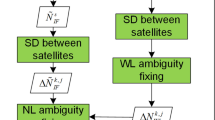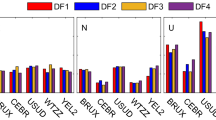Abstract
Precise point positioning (PPP) can currently achieve time transfer to a precision of one hundred picoseconds. However, the long convergence time is the main drawback of this popular time and frequency transfer method. It is well known that the convergence of position and receiver clock offset parameters in PPP solution is related to the satellite geometry, in which the receiver clock offset is the key parameter in time and frequency transfer and its performance could be reflected by the time dilution of precision (TDOP). This study applies tropospheric augmentation to accelerate PPP initialization and improve PPP frequency transfer performance during the convergence period. With the tropospheric augmentation applied to BDS-3 PPP, the convergence speed of receiver clock offset has been greatly improved when there are few visible satellites. Since GPS and BDS-3/GPS combined PPP, the satellite geometry and TDOP are better than that of BDS-3, the improvement in convergence speed is limited correspondingly. In addition, due to a more stable receiver clock offset estimated with the tropospheric information constraints, the short-term stability of frequency transfer during the convergence period has been greatly improved for GPS, BDS-3 and BDS-3/GPS combined PPP. For the two time links selected in this study, the short-term stability has been improved by more than 60, 45 and 40% in BDS-3, GPS and BDS-3/GPS combined PPP frequency transfer, respectively. However, the contribution of tropospheric augmentation to PPP frequency transfer is no longer significant after convergence.












Similar content being viewed by others
Data Availability
GNSS data are provided by the EPN data center at ftp://epncb.oma.be/. The GBM precise orbit and clock products are released by the IGS products center at https://cddis.nasa.gov/archive. And the CNES real-time products can be downloaded at http://www.ppp-wizard.net/products/REAL_TIME/.
References
Allan DW, Levine J (2016) A historical perspective on the development of the Allan variances and their strengths and weaknesses. IEEE Trans Ultrason Ferroelectr Freq Control 63(4):513–519
Bauch A, Piester D, Polewka T, Staliuniene E (2020) On the possibility of getting traceable time and frequency measurements via GNSS receivers. GPS Solut 24(4):1–13
Böhm J, Mller G, Schindelegger M, Pain G, Weber R (2015) Development of an improved empirical model for slant delays in the troposphere (GPT2w). GPS Solut 19(3):433–441
Bruyninx C, Legrand J, Fabian A, Pottiaux E (2019) GNSS metadata and data validation in the EUREF permanent network. GPS Solut 23:106
Defraigne P, Aerts W, Pottiaux E (2015) Monitoring of UTC(k)’s using PPP and IGS real-time products. GPS Solut 19(1):165–172
Dow J, Neilan R, Rizos C (2009) The international GNSS service in a changing landscape of global navigation satellite systems. J Geodesy 83(3):191–198
Ge Y, Ding S, Dai P, Qin WJ, Yang X (2020) Modeling and assessment of real-time precise point positioning timing with multi-GNSS observations. Meas Sci Technol 31(6):065016 (16pp).
Guo W, Song W, Niu X, Lou Y, Gu S, Zhang S, Shi C (2019) Foundation and performance evaluation of real-time GNSS high-precision one-way timing system. GPS Solutions 23(1).
Hadas T, Teferle F, Kazmierski K, Hordyniec P, Bosy J (2017) Optimum stochastic modeling for GNSS tropospheric delay estimation in real-time. GPS Solut 21(3):1–13
Hadas T, Hobiger T, Hordyniec P (2020) Considering different recent advancements in GNSS on real-time zenith troposphere estimates. GPS Solut 24(4):1–14
Jiang N, Xu Y, Xu T, Xu G, Schuh H (2015) GPS/BDS short-term ISB modelling and prediction. GPS Solut 21(1):1–13
Jiang Z (2015) Link calibration or receiver calibration for accurate time transfer?. In: Joint conference of the IEEE international frequency control symposium & the European frequency and time forum, pp 230–235.
Kouba J (2008) Implementation and testing of the gridded Vienna map** function 1 (VMF1). J Geodesy 82:193–205
Larson K, Levine J, Nelson L, Park T (2000) Assessment of GPS carrier-phase stability for time-transfer applications. IEEE Trans Ultrason Ferroelectr Freq Control 47:484–494
Lewis S, Inggs M (2020) Synchronisation of coherent netted radar using white rabbit compared with one-way multi-channel GPSDOs. IEEE Trans Aerospace Electronic Syst, PP (99), 1–1.
Lu C, Li X, Zus F, Heinkelmann R, Dick G, Ge M, Wickert J, Schuh H (2017) Improving BeiDou real-time precise point positioning with numerical weather models. J Geodesy 91:1019–1029
Montenbruck O et al (2017) The Multi-GNSS experiment (MGEX) of the International GNSS Service (IGS) - Achievements, prospects and challenges. Adv Space Res 59(7):1671–1697
Ouyang M, Li J, Li W, Ge Y, Dai Z (2020) Research on time and frequency transfer during PPP convergence with parameters correlation comparison. Measurement, 108597.
Petit G, Arias E (2009) Use of IGS products in TAI applications. J Geodesy 83:327–334
Ray J, Senior K (2005) Geodetic techniques for time and frequency comparisons using GPS phase and code measurements. Metrologia 42(4):215
Shi J, Xu C, Guo J, Gao Y (2014) Local troposphere augmentation for real-time precise point positioning. Earth Planets Space 66(1):1–13
Shi C, Guo S, Gu S, Yang X, Gong X, Deng Z, Ge M, Schuh H (2019) Multi-GNSS satellite clock estimation constrained with oscillator noise model in the existence of data discontinuity. J Geodesy 93:515–528
Tu R, Zhang P, Zhang R, Liu J, Lu X (2019) Modeling and performance analysis of precise time transfer based on BDS triple-frequency un-combined observations. J Geodesy 93:837–847
Wang S, Zhao X, Ge Y, Yang X (2020) Investigation of real-time carrier phase time transfer using current multi-constellations. Measurement 166(497):108237
Zhang P, Rui T, Gao Y, Na L, Rui Z (2018) Improving GALILEO’s carrier-phase time transfer based on prior constraint information. J Navigation, pp 1–19.
Zheng F, Lou Y, Gu S, Gong X, Shi C (2018) Modeling tropospheric wet delays with national GNSS reference network in china for BeiDou precise point positioning. J Geodesy 92:545–560
Zheng Z, Qian J, Mingzheng, Lei M, Song C, **e M (2019) Optical network solution to the synchronization of distributed coherent aperture radar. Opt Lett 44(8):2121 (4pp).
Acknowledgements
The authors show great gratitude to EPN Central Bureau and IGS for providing GNSS data and products. Also, acknowledgments go to the reviewers and editors whose suggestions helped us to significantly improve the manuscript. This study is supported by the National Key Research and Development Plan (Grant Nos. 2021YFB3900703) and the National Nature Science Foundation of China (Grant Nos. 42004026)
Author information
Authors and Affiliations
Corresponding author
Additional information
Publisher's Note
Springer Nature remains neutral with regard to jurisdictional claims in published maps and institutional affiliations.
Appendix
Appendix
In order to verify the contribution of our methods to real-time clock comparison and frequency transfer in PPP solution, the real-time orbit and clock products released by CNES (Centre National d’Etudes Spatiales) are adopted in the following analysis. As described in the above results, the same stations and processing strategies are used for the tropospheric modeling and clock comparison in DOY 189, 2022. Compared with the ZTD obtained with real-time GPS PPP processing, the RMS of RTGP model at CEBR, ONSA and REDU are 0.84, 0.74 and 1.08 cm, respectively. Then two time slots (15:00–16:00 and 20:00–21:00) with fewer BDS-3 satellites are selected for the clock comparison and frequency transfer of T-link1 and T-link2, respectively.
As shown in Fig. 13, when the high-accuracy prior tropospheric information is used, the STD of clock comparison results for BDS-3 PPP during the convergence period has been reduced by 4.11 ns and 0.94 ns for T-link1 and T-link2, respectively. This shows that our method can improve the convergence speed of clock comparison in real-time PPP solution. Due to the better satellite geometry, GPS standard PPP shows better performance than BDS-3 standard PPP for clock comparison. After the tropospheric augmentation is applied, the STDs of clock comparison results using GPS PPP are improved by 0.02 and 0.38 ns for two time links, respectively. For the BDS-3/GPS PPP with tropospheric augmentation, the STD during the convergence period has been improved by 0.38 and 0.35 ns for T-link1 and T-link2, respectively.
Due to the faster convergence speed and mitigation of fluctuation on the clock comparison results by using tropospheric augmentation, a great improvement has been achieved for BDS-3, GPS and BDS-3/GPS real-time PPP frequency transfer. As shown in Fig. 14, all of the MDEV at different averaging times have been significantly improved for the two time links. For the different averaging time on T-link1, the stability of BDS-3 frequency transfer has been improved by 45–92%, while the stability of GPS and BDS-3/GPS frequency transfer are improved by 16.9–56.9% and 16.1–68.7%, respectively. In terms of frequency stability on T-link2 results, the improvements in BDS-3 PPP range from 49.4 to 62.4%, and the improvements in GPS and BDS-3/GPS PPP are 22.6–68.2 and 6.9–58.3%, respectively.
Rights and permissions
Springer Nature or its licensor (e.g. a society or other partner) holds exclusive rights to this article under a publishing agreement with the author(s) or other rightsholder(s); author self-archiving of the accepted manuscript version of this article is solely governed by the terms of such publishing agreement and applicable law.
About this article
Cite this article
Zhang, D., Shi, C., Zheng, F. et al. Rapid frequency transfer by BDS-3/GPS PPP with tropospheric augmentation. GPS Solut 27, 41 (2023). https://doi.org/10.1007/s10291-022-01376-3
Received:
Accepted:
Published:
DOI: https://doi.org/10.1007/s10291-022-01376-3






